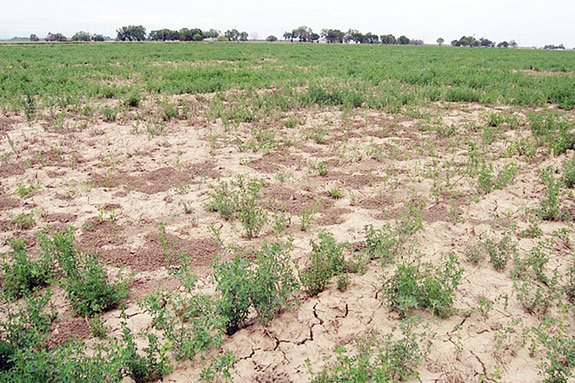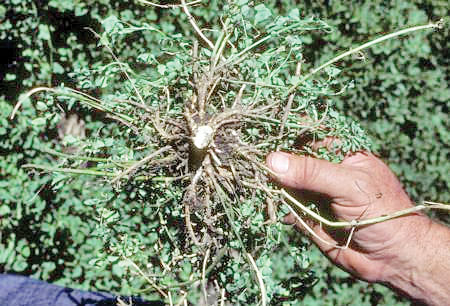Gophers are short, stout burrowing rodents, usually six to eight inches in length. They spend most of their time below-ground where they use their front legs and large incisors to create extensive burrow systems.
Gophers will breed anywhere from one to three times per year. Therefore, continuous monitoring and control of gopher populations is needed to keep their numbers low.
Although gophers can breed at different times throughout the year, there is typically a pulse in reproduction toward early to mid-spring.
As such, control measures implemented before this reproductive pulse will often be more effective as there will be fewer gophers to control at that time.

If left unchecked, gophers will cause extensive damage to alfalfa. This damage includes consumption of tap roots and above-ground vegetation that can result in reduced vigor or mortality of alfalfa plants, loss of irrigation water down burrow systems and chewing on underground drip lines.
Gopher mounds can result in additional problems including serving as weed seed beds, burying of plants and causing damage to farm equipment.
An effective management plan for gophers usually involves the use of multiple control methods (i.e., IPM). There are many combinations of control techniques that can be incorporated into an IPM program for gophers.
Keep in mind that with large gopher populations, multiple applications of these control techniques may be needed to eliminate an acceptable percentage (at least 70 percent) of the population.
Each grower will have a unique set of circumstances that will influence what is best for them. That being said, here are some of the most effective or most commonly used techniques for controlling gophers in alfalfa.
• Toxic baits – There are three primary toxicants for gopher control: strychnine, zinc phosphide and anticoagulants (e.g., chlorophacinone and diphacinone).
Both strychnine and zinc phosphide are considered acute toxicants. This means they kill after a single feeding. Strychnine comes in two concentrations in California: 0.5 percent and 1.8 percent.

The 0.5 percent concentration is typically used for hand baiting, while the 1.8 percent concentration is used both for hand baiting and in a burrow builder.
Zinc phosphide is also available for gopher control; it comes in a 2.0 percent concentration.
Bait acceptance can be an issue with zinc phosphide, as it has a distinctive odor and taste that gophers are often averse to.
In contrast to acute toxicants, gophers must consume anticoagulants multiple times over the course of three to five days to receive a toxic dose.
This requires larger amounts of bait to maintain a consistent supply over this time period. Because of this, anticoagulants are used less frequently for gopher control – although newer anticoagulant products are available and may be more effective but have yet to be thoroughly tested.
At present, 1.8 percent strychnine is usually considered the most effective toxicant.
There are two primary methods for baiting in alfalfa fields: hand baiting with an all-in-one probe/bait dispenser and a burrow builder.
Hand baiting can be effective if you have relatively few gophers in a field. For this approach, an all-in-one probe and bait dispenser is used to locate and apply bait to a gopher tunnel.
When treating large areas, the burrow builder may be a more practical bait application method. The burrow builder is a device that is pulled behind a tractor on a three-point hitch and creates an artificial burrow at a set depth.
Bait is then deposited at set intervals along the artificial burrow. While engaging in normal burrowing activity, gophers will come across these artificial burrows and consume the bait within.
Although convenient to treat large areas, the efficacy of this method has varied quite extensively from grower to grower. Experimentation is key to determining the applicability of this approach for each grower.
• Fumigation – Primary fumigants used for burrowing rodent control are gas cartridges and aluminum phosphide. Studies have shown that gas cartridges are not effective for gophers.
Aluminum phosphide, however, is quite effective and has a very low material cost. The key with aluminum phosphide treatments is to only apply when soil moisture is relatively high.
Because of this, fumigation is typically most effective in late winter and early spring, although fumigation after irrigation can also be a good strategy.
In addition to aluminum phosphide, carbon monoxide-generating machines can now legally be used to control gophers in California.
As their name implies, these devices generate carbon monoxide and inject it into the burrow systems, which then asphyxiates the inhabitants.
Early trials have indicated that this approach is moderately effective, although more research is needed to substantiate these initial trials.
• Trapping – Trapping is safe and one of the most effective, although labor-intensive, methods for controlling gophers. Nonetheless, the cost and time for application may be offset by high efficacy.
Several types and brands of gopher traps are available. The most common type is a two-pronged, pincher trap such as the Macabee, Cinch or Gophinator, which the gopher triggers when it pushes against a flat, vertical pan.
Another popular type is the choker-style box trap, although these traps require extra excavation to place and may be a bit bulky to be practical in a large field setting.
Traps are either placed into main tunnels or lateral tunnels that lead directly to the surface. Trapping in lateral tunnels can be quicker and easier to implement, but is less effective at certain times of the year (e.g., summer) and for more experienced gophers (e.g., adult males).
• Biocontrol – This approach relies on natural predation to control gopher populations. From a management perspective, this typically involves the use of owl boxes to encourage owl predation of gophers over alfalfa fields.
Unfortunately, no replicated scientific study has ever been able to show that owls substantially reduce gopher populations in a field.
• Cultural practices – Cultivation is the best example of a cultural practice in alfalfa. If you have an alfalfa field that you are going to replant, deep ripping will eliminate many of the gopher burrow systems and will kill some gophers in the process.
Destroying the burrow systems helps slow down potential reinvasion into fields and, when combined with an aggressive gopher control program post-cultivation, can provide a “clean slate” for a newly planted alfalfa field.
• Flood irrigation – Where still feasible, flood irrigation can help control gopher populations. When a field is flooded, the gophers must come to the surface or drown.
When at the surface, they can be picked off by a number of predators; growers and their dogs can also actively seek out gophers at this time to further reduce populations of these damaging pests.
• Gas explosive device – This is an instrument that injects a mixture of propane and oxygen into the burrow system and then ignites – this mixture thereby potentially killing the gopher through a concussive force.
This approach has the added benefit of destroying the burrow systems which should slow down reinvasion rates by burrowing rodents. However, initial studies have not shown it to be overly effective for many burrowing rodent species. FG
PHOTOS
TOP: Pocket gopher.
MIDDLE and BOTTOM: If left unchecked, gophers will cause extensive damage to alfalfa. This damage includes consumption of tap roots and above-ground vegetation. Photos courtesy of Roger Baldwin.









